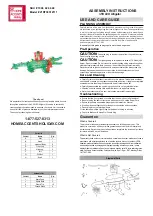
134 Chapter 2 Network configuration
208700-B
•
When you set any trunk member to Disabled (not active) through the Port
Configuration screen or through network management, the trunk member is
removed from the trunk. The trunk member has to be reconfigured to rejoin
the trunk through the Trunk Configuration screen on the CI menus, or another
management system. A screen prompt precedes this action when you are
using CI menus. A trunk member cannot be disabled if there are only two
trunk members on the trunk.
•
You cannot configure a trunk member as a monitor port (see Chapter 3).
•
Trunks cannot be monitored by a monitor port; however, trunk members can
be monitored (see
“Port-based mirroring configuration
”).
•
All trunk members must have identical IGMP configurations.
•
If you change the IGMP snooping configuration for any trunk member, the
IGMP snooping settings for all trunk members change.
How the MultiLink Trunk reacts to losing distributed trunk
members
If your MultiLink Trunk (
Figure 42
) spans separate units in a stack configuration
and any of those units (or trunked MDAs) becomes inactive from a loss of power
or unit failure, the unaffected trunk members remain operational.
Summary of Contents for 2000
Page 16: ...16 Contents 208700 B ...
Page 22: ...22 Figures 208700 B ...
Page 26: ...26 Tables 208700 B ...
Page 32: ...32 Preface 208700 B ...
Page 86: ...86 Chapter 1 The Business Policy Switch 2000 208700 B ...
Page 272: ...272 Chapter 3 Using the console interface 208700 B ...
Page 292: ...292 Chapter 4 Policy enabled networks 208700 B ...
Page 326: ...326 Chapter 5 Sample QoS configuration 208700 B ...
Page 346: ...346 Appendix B Interoperability in a mixed stack configuration 208700 B ...
Page 368: ...368 Appendix C Media dependent adapters 208700 B ...
Page 386: ...386 Appendix E Connectors and pin assignments 208700 B ...
















































